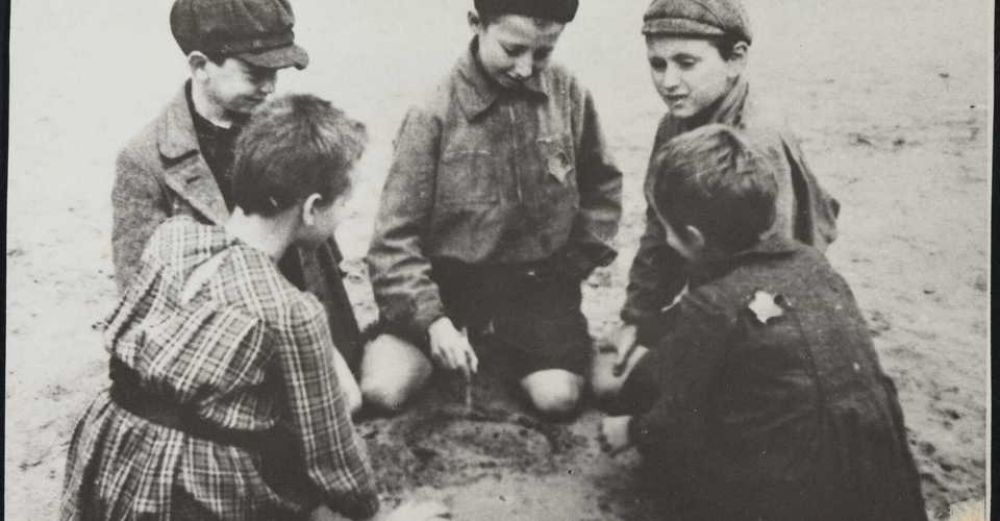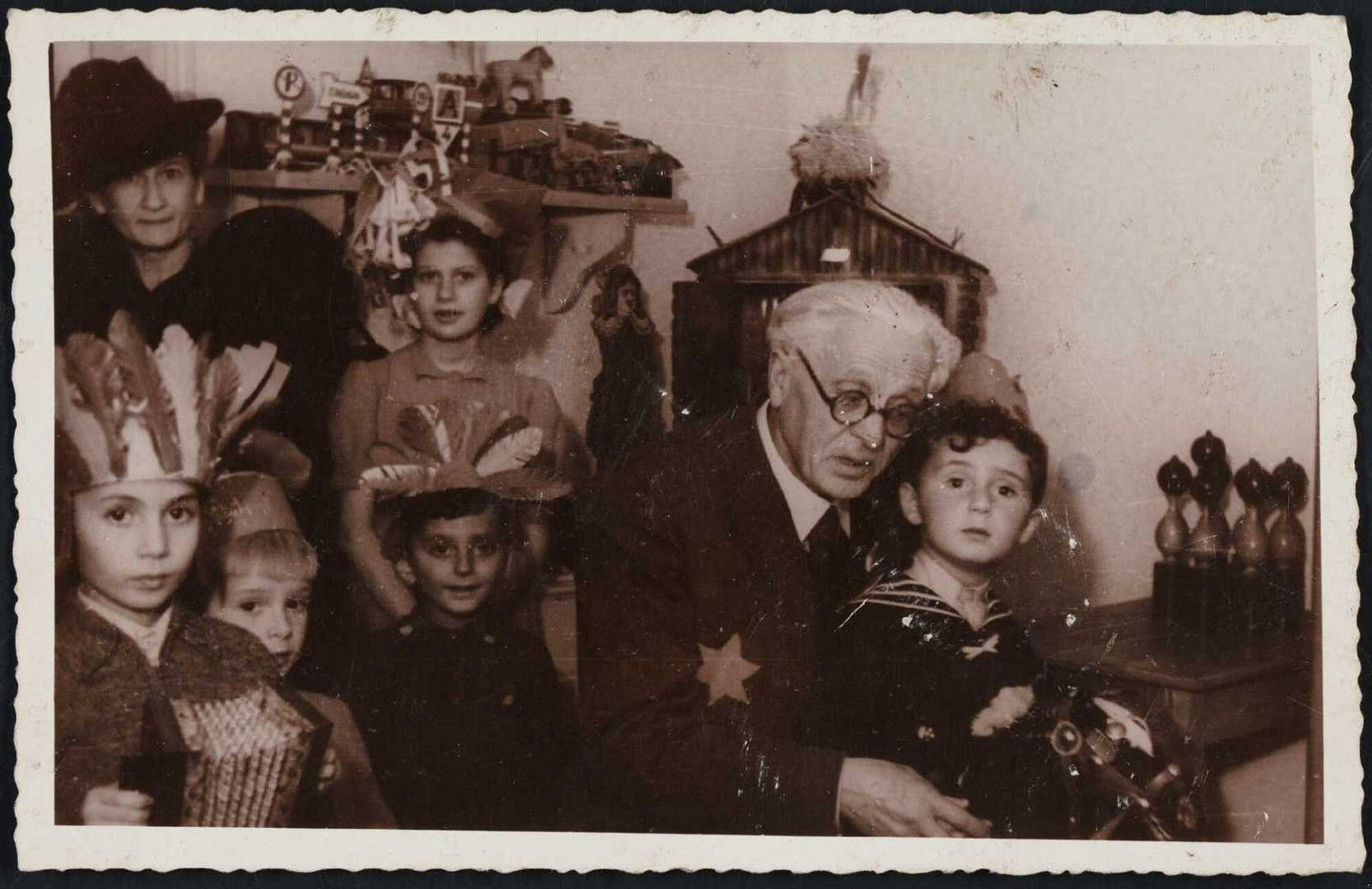- News
- Events
- Oneg Shabbat
- Collections
- Research
- Exhibitions
- Education
- Publishing Department
- Genealogy
- About the Institute
- Bookstore


The group of children playing in the sand. /
On 8 February 1940, German authorities have announced that a ghetto was established in occupied Łódź. The ghetto was separated from the rest of the city, surrounded with a fence, and guarded by German police formations as well as members of the Jewish Ghetto Police. During the four years of the Łódź Ghetto existence, over 200,000 people had lived there – both the Jews of Łódź and nearby areas as well as people deported from the Third Reich and the Protectorate of Bohemia and Moravia. The Ghetto existed until 29 August 1944. In that time, about 45,000 people died due to hunger and diseases. The remaining people were killed in extermination camps – in Chełmno nad Nerem (Kulmhof am Nehr) and Auschwitz-Birkenau. It is estimated that only about 5 to 7 thousand people survived until the end of the war.
The most tragic moment in the history of the Łódź Ghetto was „Wielka Szpera” (from German: Allgemeine Gehsperre – prohibition to leave homes), mass deportation to the extermination camp, which impacted mainly children under the age of ten and the elderly over the age of 65, as well as ill people and those who weren’t employed. The decision about deportation was made in late August 1942 at the Main Reich Security Office (Reichssicherheitshauptamt – RSHA). During the „Wielka Szpera”, between 5 and 12 September 1942, more than 15,000 people were sent to the extermination camp in Chełmno nad Nerem. Only a small group was spared from the deportation – children from the privileged families in the ghetto community (police officers, firefighters, directors of main departments).
The period between 5–12 September 1942 will scar for life those of the ghetto community who will survive the war. One week! Eight days which seem like eternity. Today, it is still difficult to realize what happened. A typhoon wiped out about 15,000 people (nobody can give a precise estimate yet), and life came back to its previous course.
A few days before the deportation, on 1 and 2 September, the hospitals and the Central Prison were evacuated – about 2000 patients altogether. „The evacuation of hospital patients made a terrible impact on the ghetto and spread panic. People passed the worst possible forecasts between each other”, noted The Chronicle of the Ghetto. Some patients were trying to escape; many of them were killed. Members of the personnel who opposed the orders were killed as well.
The tragedy of the ill and their families is beyond words.
Someone’s brother, someone’s sister, someone’s father, someone’s mother, cousin, aunt! Everyone left somebody. Such a despair wasn’t seen even at the height of the deportations, such cries and laments hadn’t been heard before. Here and there, we can see small groups of crying women, children, helpless men who had to bid farewell to their loved ones in such an unbelievable way.
And how difficult it was to get someone in the hospital, how much protection it required to obtain a bed, even in the corridor. Families were so relieved that their loved ones could get medical care! And now this...
The reason [of the evacuation] remains unknown, perhaps the only possibility being that new departments could be established at the hospital buildings – but new barracks for the ill were being built at Krawiecka/Tokarzewskiego, and they were about to be completed. Why such a rush? Why so suddenly?
Our minds are in agitation, the moods are terrible, it is difficult to come to any conclusion.
The particularly dramatic deportations were preceded by the famous, often quoted speech given by Chaim Mordechaj Rumkowski. On 4 September 1942, the Head of the Council of Elders said:
A grievous blow has struck the ghetto. They are asking us to give up the best we possess — the children and the elderly. […] In my old age, I must stretch out my hands and beg: brothers and sisters — hand them over to me. Fathers and mothers: give me your children! […] I must perform this difficult and bloody operation — I must cut off limbs in order to save the body itself. I must take children because, if not, others may be taken as well — God forbid. […] I reach out to you with my broken, trembling hands and beg: give into my hands the victims. So that we can avoid having further victims, and a population of 100,000 Jews can be preserved.

On 5 September, on the walls of the ghetto, an announcement about general curfew (Allgemeine Gehsperre) appeared. On the same day, the Deportation Commission was established. In the following days, members of the Jewish Ghetto Police and the Special Unit were taking away people on the basis of lists of names and delivering them to the train station. The actions of the Jewish Ghetto Police caused great outrage in the ghetto.
The police performed their tasks quietly and efficiently at the nursing home. Nobody bothered them, nobody made them angry, nobody’s hands shook... […] At Rybna street, it was neither peacefully nor efficiently. The police had to force people away from their flats. They were met with resistance. They had to cut off one body from another, because they pulled babies from their mothers’ breasts. They pulled healthy teeth out of a jaw, because mothers and fathers didn’t want to give away their children, a few years old already. They separated wives and husbands, who shared lives in joy and sorrow for thirty, or even fifty years, had children and were like one body.
The German authorities had decided that the Jewish Ghetto Police wasn’t efficient enough. On 7 September, the German police and Gestapo entered the Łódź Ghetto. Their selection was even more brutal than the actions of the Jewish police. They used guns anytime they encountered resistance. In this period, many people who previously managed to avoid deportation, were sent to the extermination camp. Germans were often shooting without prior warning, killing people on the street.
Oh, Jewish God, how cheap has Jewish blood become! Oh, God of all creatures, human blood is being spilled with such impunity!
Blood is flowing down the streets, in homes, inside rooms. Not healthy, bright-coloured blood; there’s no such blood in the ghetto, because three yeears of war and two and half years of isolation deprived it of red blood cells... There’s only pus and bile flowing down from eyes and through the streets, yards and rooms.
12 September 1942 marked the end of „wielka szpera”. Two announcements were published in the ghetto: the renouncement from „szpera” and the reopening of factories. According to offocial data, during the September deportations 15,681 people were deported, several hundred were shot for resistance, 35 were hanged for escaping the transport or leaving their workplace. From that moment on, the Łódź Ghetto became a labor camp.
The life in the ghetto is seemingly normal. On the outside, it returned to its normal form, but it’s only an impression. The wound is healing on the outside, but the blood keeps flowing inside and nobody knows if it ever could end.
Buildings at the „firefighters’s square” at Lutomierska street, where Rumkowski gave his speech before the September deportations, don’t exist anymore. New blocks were built in the area. Only one house survived – in front of this building, the Head of the Council of Elders was calling for the prisoners of the Łódź Ghetto to give him their children.
Bibliography:
Encyklopedia getta. Niedokończony projekt archiwistów z getta łódzkiego, wyd. Radziszewska K., Wiatr E., Sitarek A. Walicki J., Polit M., Łódź 2014.
Józef Zelkowicz. Notatki z getta łódzkiego 1941–1944, red. Trębacz M., Wiatr E., Polit M., Radziszewska K., Łódź 2016.
Kronika getta łódzkiego/Litzmannstadt Getto, t. 2, red. Baranowski J., Radziszewska K., Sitarek A., Trębacz M., Walicki J., Wiatr E., Zawilski P., Łódź 2009.
Löw A., Getto łódzkie/Litzmannstadt Getto. Warunki życia i sposoby przetrwania, Łódź 2012.
Sitarek A., Otoczone drutem państwo, Łódź 2015.